Three-Dimensional Porous PVDF Foam Imprinted Membranes with High Flux and Selectivity toward Artemisinin/Artemether
Abstract
:1. Introduction
2. Results and Discussion
2.1. Optimization of the Reactant Ratio of Foam PVDF Membrane
2.2. Morphology Analysis
2.3. Membrane Pore Size Analysis
2.4. FT-IR Analysis
2.5. Wettability Analysis
2.6. Membrane Flux Studies
2.7. Mechanical Performance Analysis
2.8. Static Adsorption Experiment
2.9. Dynamic Adsorption Experiment
2.9.1. Crossflow Adsorption of Different Flow Rates
2.9.2. Crossflow Selective Separation
2.10. Reusability
3. Experimental Section
3.1. Apparatus
3.2. Reagents and Materials
3.3. Synthesis of MIPs
3.4. Preparation of Foam PVDF/PDA-Based Imprinted Membrane (PPIM)
3.5. Characterization
3.6. Static Adsorption Experiments
3.7. Dynamic Adsorption Experiment
3.7.1. Crossflow Separation Experiment
3.7.2. Crossflow Selective Separation Experiment
3.7.3. Reusability Experiments
4. Conclusions
Supplementary Materials
Author Contributions
Funding
Conflicts of Interest
References
- Lee, B.J.; Weyers, M.; Haynes, R.K.; Kooy, F. Discovery of artemisinin in Artemisia annua, its current production, and relevance to sub-Saharan Africa. S. Afr. J. Bot. 2023, 153, 21–27. [Google Scholar] [CrossRef]
- Efferth, T.; Oesch, F. The immunosuppressive activity of artemisinin-type drugs towards inflammatory and autoimmune diseases. Med. Res. Rev. 2021, 41, 3023–3061. [Google Scholar] [CrossRef] [PubMed]
- Meng, M.; Wang, S. UiO-66-NH2 as a novel ultrahigh-selective adsorbent superior to molecularly imprinted polymers for the adsorption of artesunate. Colloid. Surf. A 2022, 644, 128830. [Google Scholar] [CrossRef]
- Souza, A.; Grabe-Guimarães, A. Mechanisms of artemether toxicity on single cardiomyocytes and protective effect of nanoencapsulation. Br. J. Pharmacol. 2020, 177, 4448–4463. [Google Scholar] [CrossRef] [PubMed]
- Yaseneva, P.; Plaza, D.D. Synthesis of the antimalarial API artemether in a flow reactor. Catal. Today 2015, 239, 90–96. [Google Scholar] [CrossRef]
- Sissoko, A.; Vasquez-Ocmín, P. A chemically stable fluorescent mimic of dihydroartemisinin, artemether, and arteether with conserved bioactivity and specificity shows high pharmacological relevance to the antimalarial drugs. J. Am. Chem. Soc. 2020, 6, 1532–1547. [Google Scholar] [CrossRef]
- Abu-Alsoud, G.F.; Hawboldt, K.A. Assessment of cross-reactivity in a tailor-made molecularly imprinted polymer for phenolic compounds using four adsorption isotherm models. J. Chromatogr. A 2020, 1629, 461463. [Google Scholar] [CrossRef]
- Cantarella, M.; Carroccio, S.C. Molecularly imprinted polymer for selective adsorption of diclofenac from contaminated water. Chem. Eng. J. 2019, 367, 180–188. [Google Scholar] [CrossRef]
- Cowen, T.; Stefanucci, E. Synthetic mechanism of molecular imprinting at the solid phase. Macromolecules 2020, 53, 1435–1442. [Google Scholar] [CrossRef]
- Azimi, M.; Golsefidi, M.A. A novel method for extraction of galegine by molecularly imprinted polymer (MIP) technique reinforced with graphene oxide and its evaluation using polarography. J. Anal. Methods Chem. 2020, 9, 3646712. [Google Scholar] [CrossRef]
- Donato, L.; Drioli, E. Imprinted membranes for sustainable separation processes. Chem. Sci. Eng. 2021, 15, 775–792. [Google Scholar] [CrossRef]
- Meng, M.J.; Li, Y. Hydrophilic imprinted MnO2 nanowires “coating” membrane with ultrahigh adsorption capacity for highly selective separation of Artemisinin/Artemether. Chem. Eng. J. 2023, 466, 143020. [Google Scholar] [CrossRef]
- Yoshikawa, M.; Tharpa, K. Molecularly imprinted membranes: Past, present, and future. Chem. Rev. 2016, 116, 11500–11528. [Google Scholar] [CrossRef] [PubMed]
- Wang, Y.H.; Li, L. Preparation and recognition properties of molecularly imprinted nanofiber membrane of chrysin. Polymers 2022, 14, 2398. [Google Scholar] [CrossRef] [PubMed]
- Ramamoorthy, M.; Ulbricht, M. Molecular imprinting of cellulose acetate-sulfonated polysulfone blend membranes for Rhodamine B by phase inversion technique. J. Membr. Sci. 2003, 217, 207–214. [Google Scholar] [CrossRef]
- Wang, H.Y.; Kobayashi, T.; Fujii, N. Molecular imprint membranes prepared by the phase inversion precipitation technique. Langmuir 1996, 12, 4850–4856. [Google Scholar] [CrossRef]
- Zhang, K.; Li, Y. Precise identification and transport of specific molecules through framework functionalized membranes with multiple binding sites. J. Membr. Sci. 2023, 670, 121327. [Google Scholar] [CrossRef]
- Yan, J.; Zhang, K.; Ma, F.; Cui, H.; Wu, Y. Scalable basswood-based PDA/GO-embedded self-assembly membrane within multilayered artemisinin-imprinted nanocage for high-selectivity cascading adsorption and transport. Chem. Eng. J. 2023, 462, 142277. [Google Scholar] [CrossRef]
- Zhang, K.C.; Yan, M. Precise identification and ultrafast transport of specific molecules with nanofluid functionalized imprinted membrane. J. Hazard. Mater. 2023, 451, 131134. [Google Scholar] [CrossRef]
- Li, B.; Guo, Z. LDHs-based 3D modular foam with double metal-fluorine interaction for efficiently promoting peroxymonosulfate activation in water pollutant control. Chem. Eng. J. 2021, 425, 131541. [Google Scholar] [CrossRef]
- Lee, H.; Dellatore, S.M. Mussel-inspired surface chemistry for multifunctional coatings. Sci. Adv. 2007, 426, 318. [Google Scholar] [CrossRef] [PubMed]
- Zhou, W.H.; Lu, C.H. Mussel-inspired molecularly imprinted polymer coating superparamagnetic nanoparticles for protein recognition. J. Mater. Chem. 2010, 20, 880–883. [Google Scholar] [CrossRef]
- Aysin, F.; Yilmaz, A. Metallic nanoparticle-secorated polydopamine thin films and their cell proliferation characteristics. Coatings 2020, 10, 802. [Google Scholar] [CrossRef]
- Wu, Y.L.; Liu, X.L. Bio-inspired adhesion: Fabrication of molecularly imprinted nanocomposite membranes by developing a hybrid organic-inorganic nanoparticles composite structure. J. Membr. Sci. 2015, 490, 169–178. [Google Scholar] [CrossRef]
- Wu, Y.L.; Liu, X.L. Bioinspired synthesis of high-performance nanocomposite imprinted membrane by a polydopamine-assisted metal-organic method. J. Hazard. Mater. 2017, 323, 663–673. [Google Scholar] [CrossRef]
- Li, B.; Meng, M. Photocatalytic membranes BPMs: Focus on improving photocatalytic performance of Fe3O4/g-C3N4/PVDF membranes through magnetically induced freezing casting method. Chem. Eng. J. 2019, 365, 405–414. [Google Scholar] [CrossRef]
- Chen, B.D.; Wang, J. Adsorption of uranium from uranium mine contaminated water using phosphate rock apatite PRA: Isotherm, kinetic and characterization studies. Coll. Surf. A 2017, 520, 612–621. [Google Scholar] [CrossRef]
- Zhang, Y.; Tan, X. Fabrication of multilayered molecularly imprinted membrane for selective recognition and separation of artemisinin. ACS Sustain. Chem. Eng. 2019, 7, 3127–3137. [Google Scholar] [CrossRef]
- Wu, Y.; Meng, M. Efficient one-pot synthesis of artemisinin-imprinted membrane by direct surface-initiated AGET-ATRP. Sep. Purif. Technol. 2014, 131, 117–125. [Google Scholar] [CrossRef]
- Wu, Y.; Lin, R. Membrane-associated molecularly imprinted surfaces with tailor-made SiO2@polydopamine-based recognition sites for selective separation of artemisinin. Colloid Surf. A 2021, 622, 126645. [Google Scholar] [CrossRef]
- Gong, X.Y.; Cao, X.J. Preparation of molecularly imprinted polymers for artemisinin based on the surfaces of silica gel. J. Biotechnol. 2011, 153, 8–14. [Google Scholar] [CrossRef] [PubMed]
- Yang, B.; Cao, X. Synthesis of the artemisinin-imprinting polymers on silica surface and its adsorption behavior in supercritical CO2 fluid. AlChE J. 2011, 57, 3514–3521. [Google Scholar] [CrossRef]
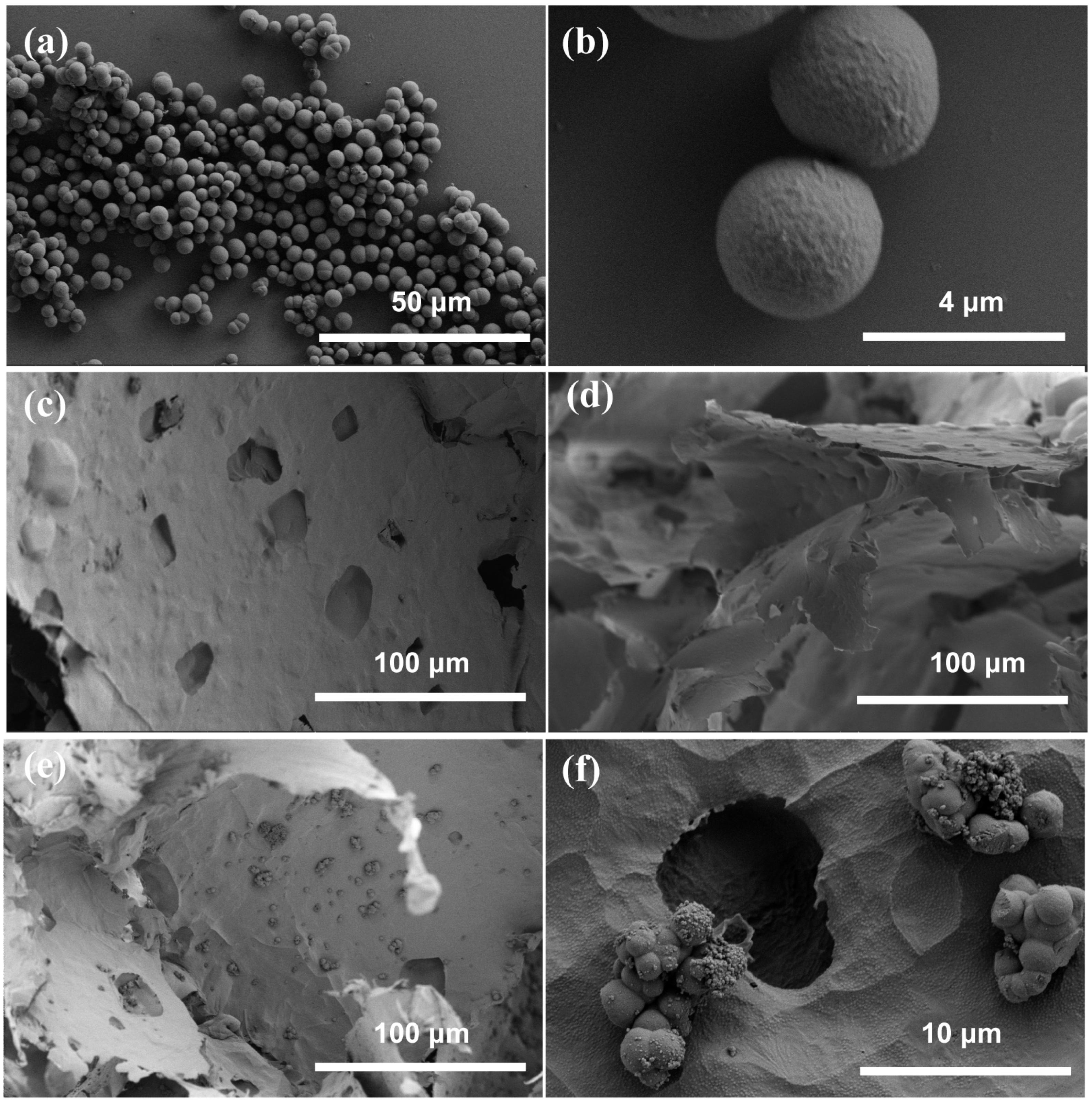
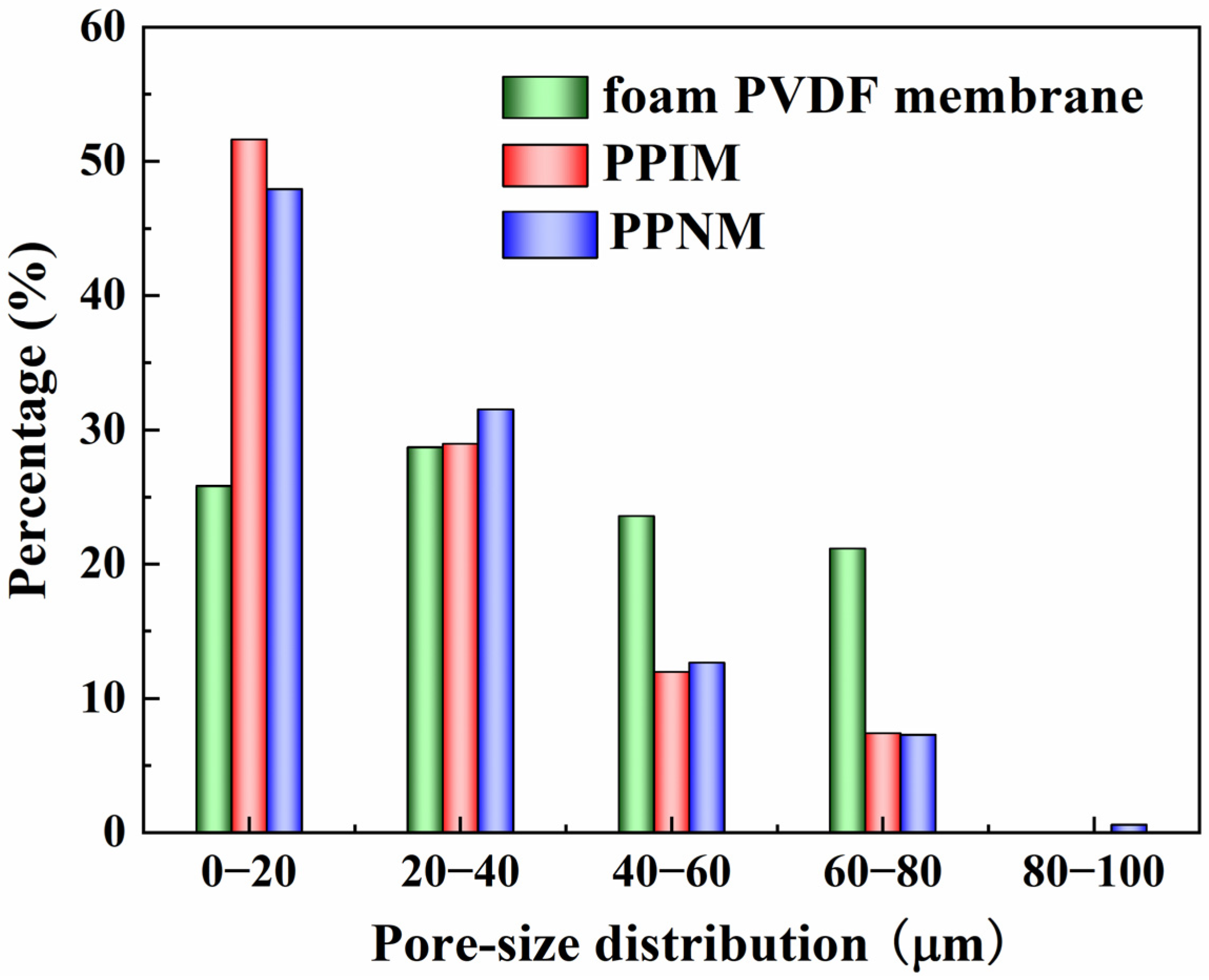
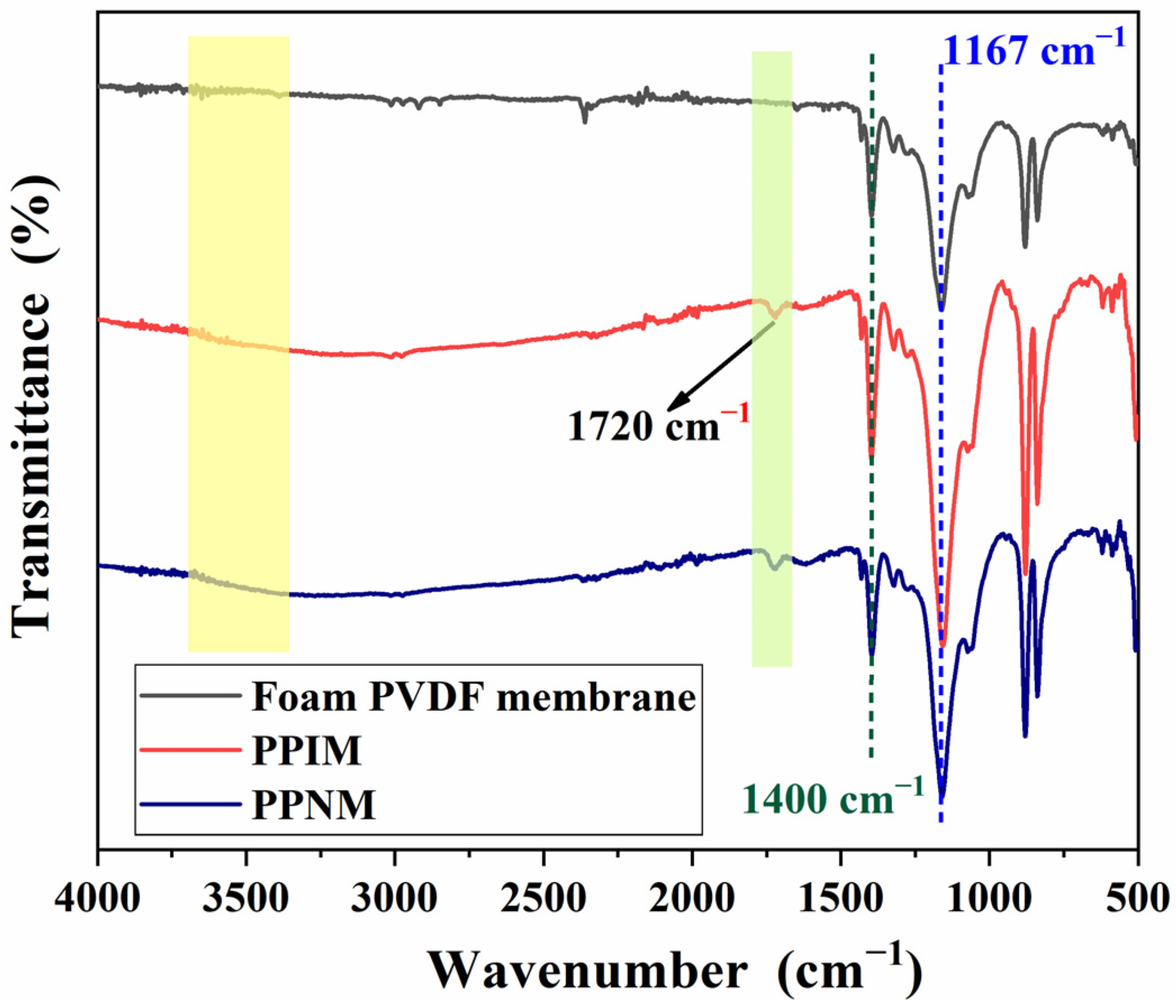

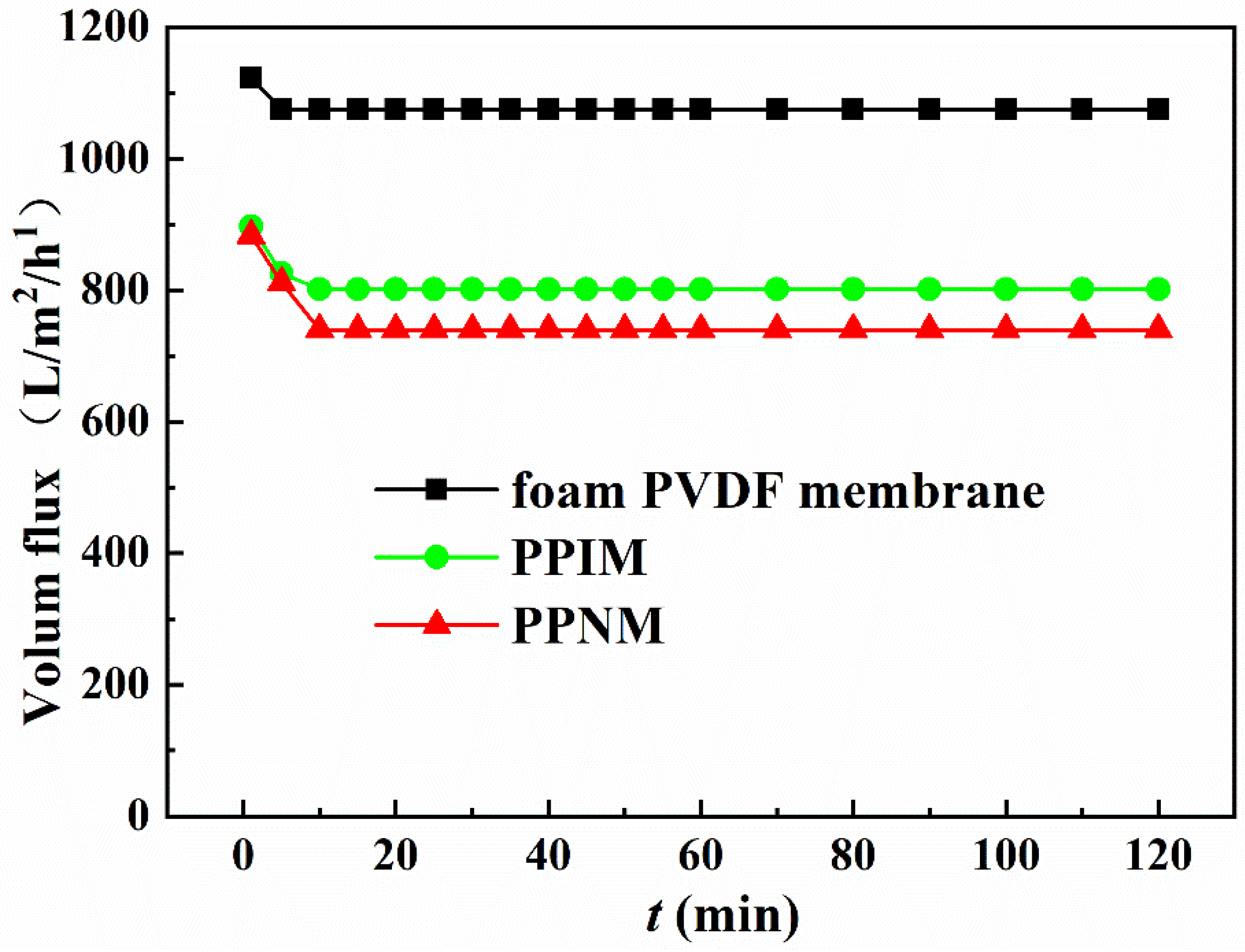
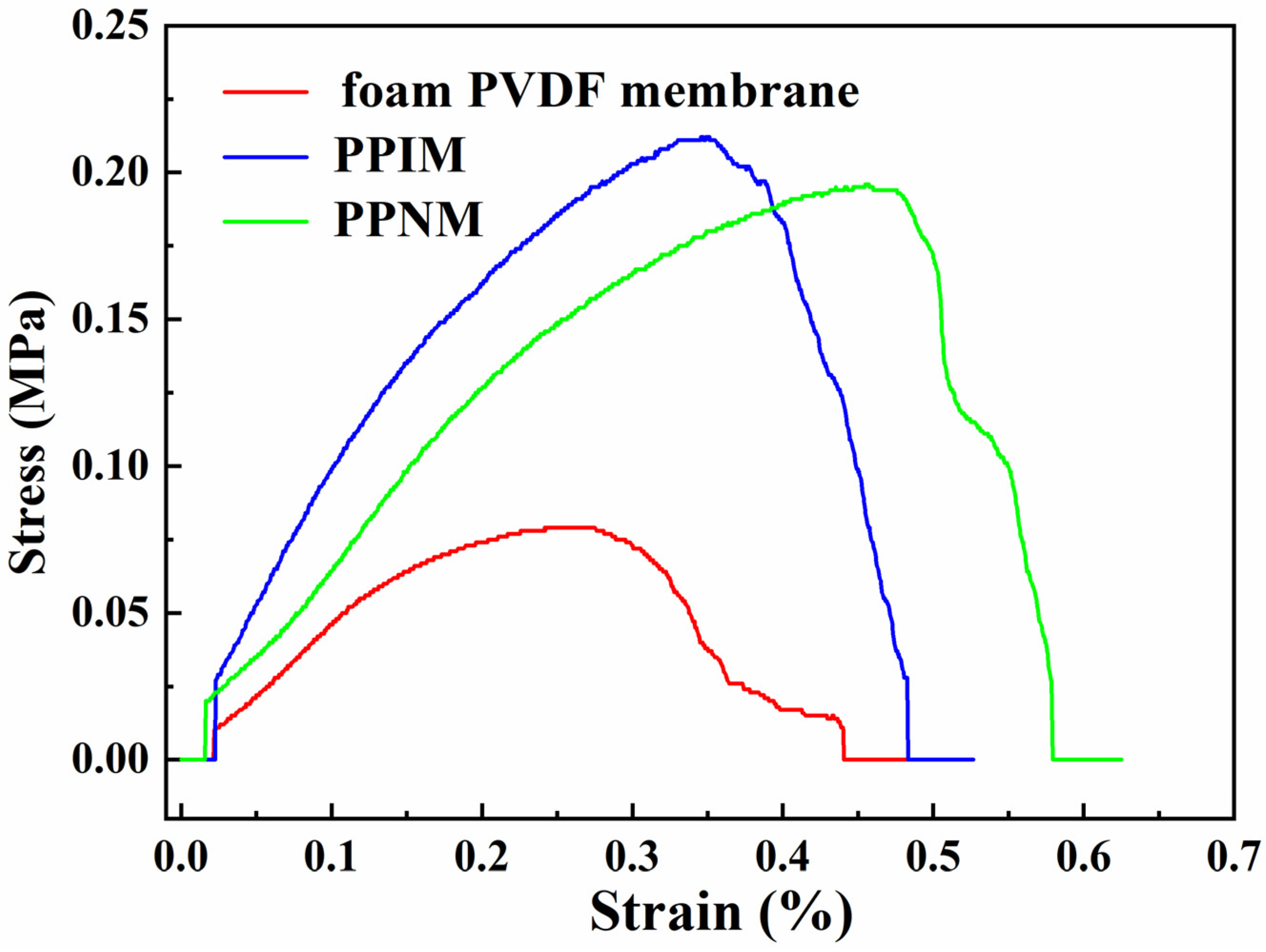
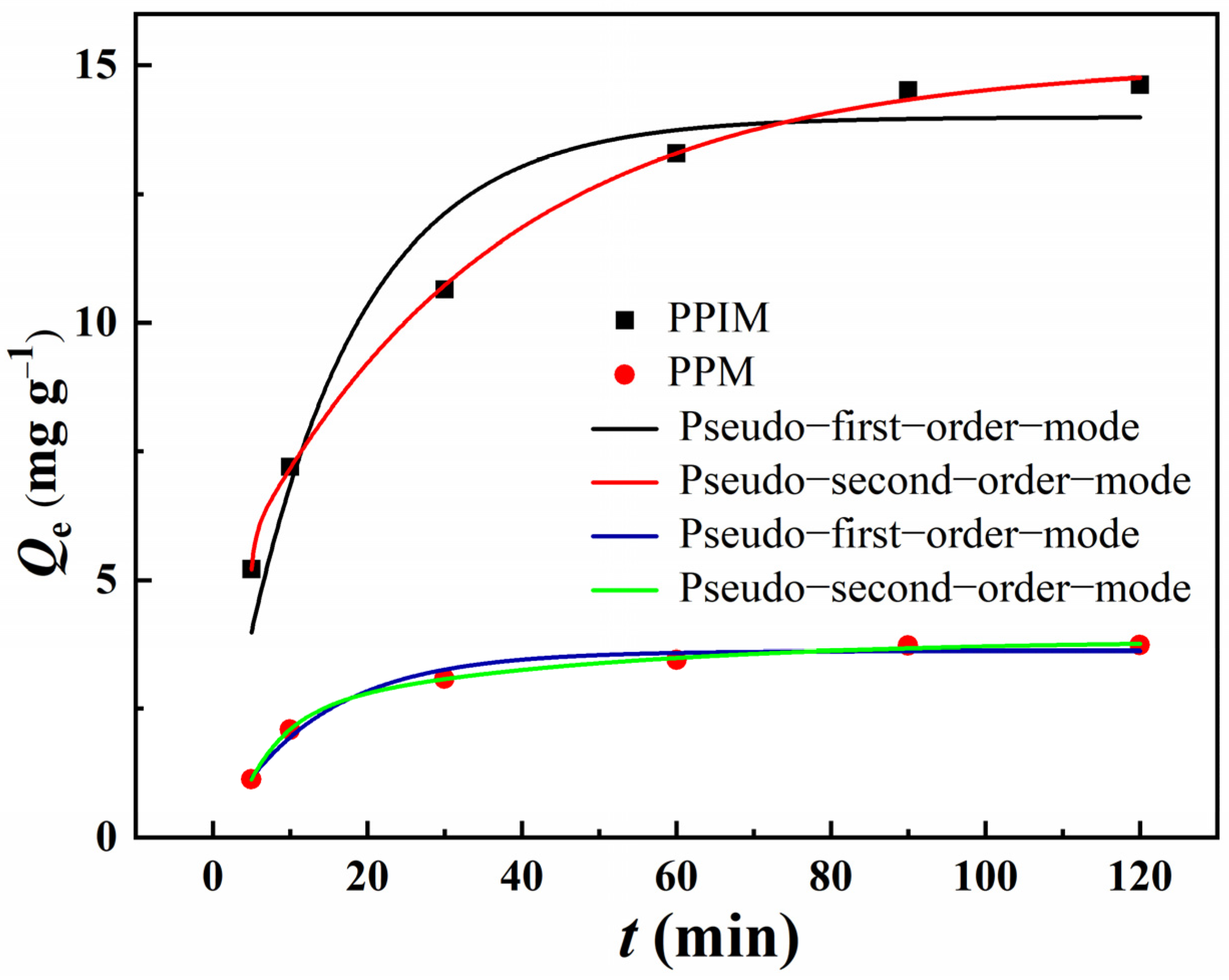
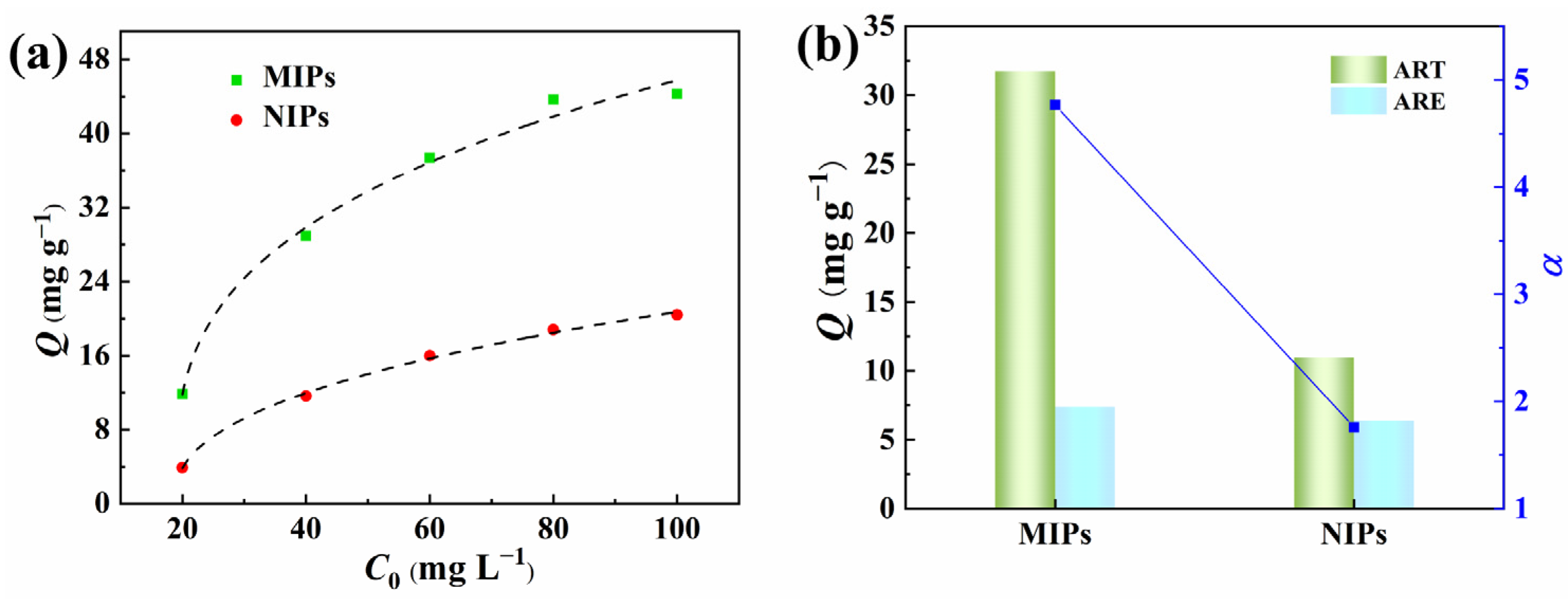
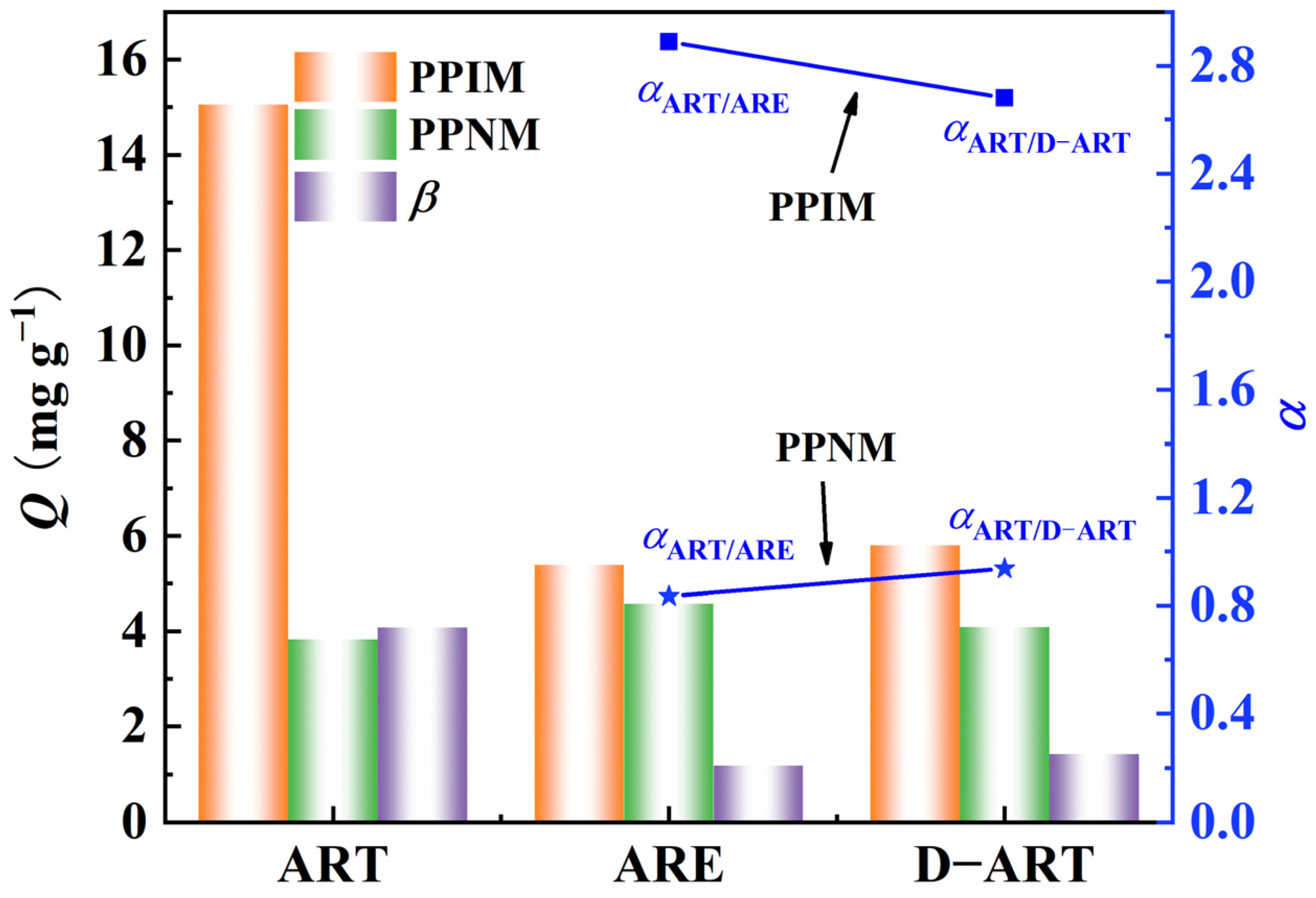
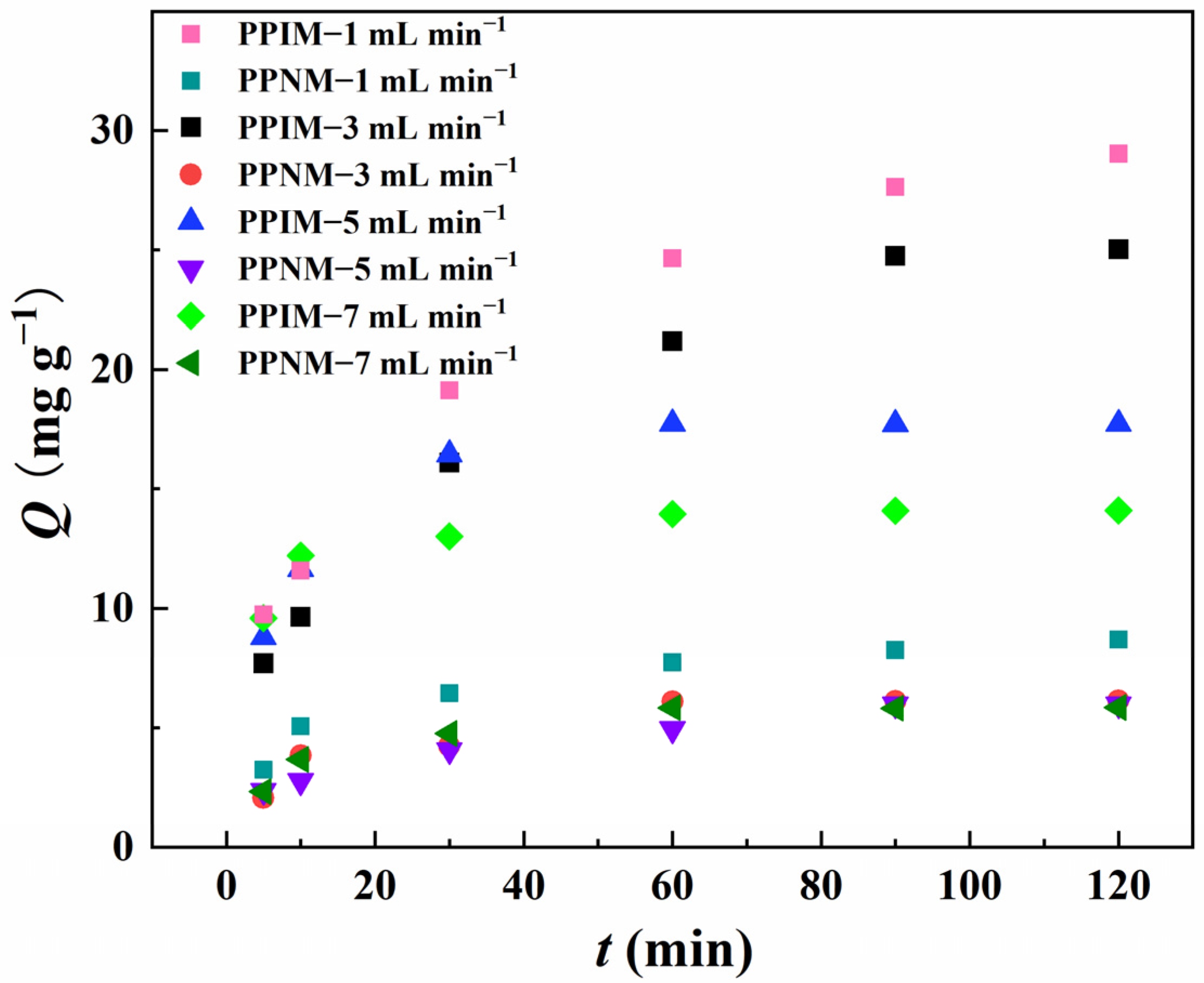
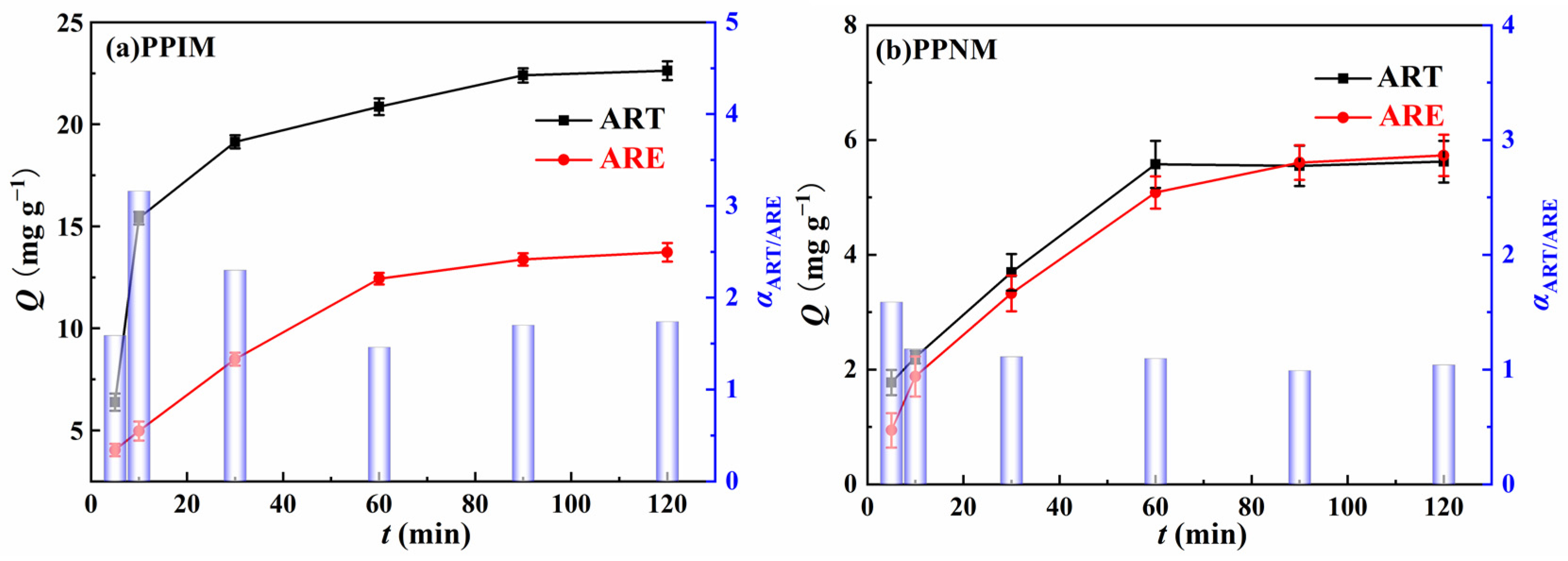
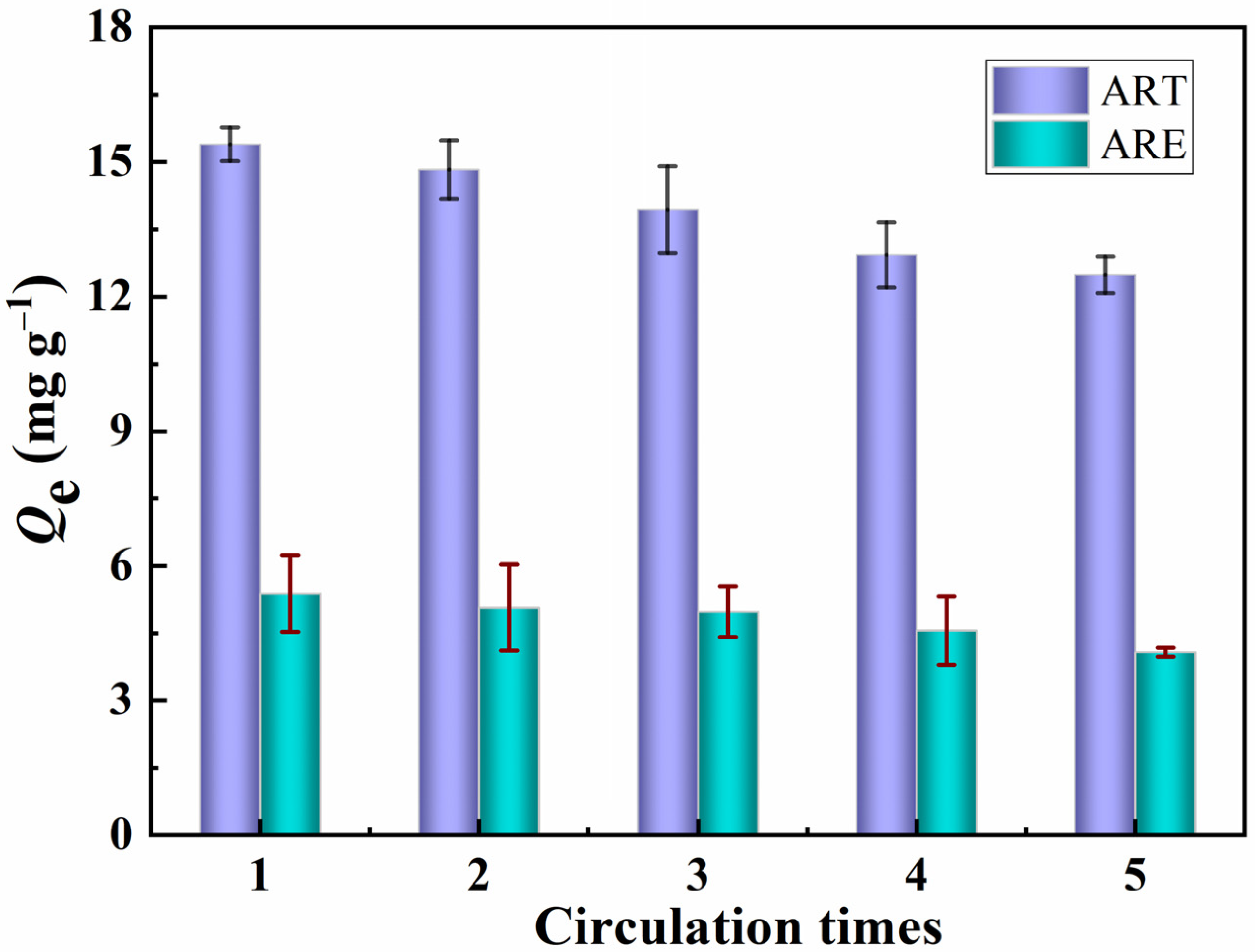
| Pseudo−First−Order Kinetic Equation | Pseudo−Second−Order Kinetic Equation | |||||
|---|---|---|---|---|---|---|
| k1 (min−1) | Qe (mg g−1) | R2 | k2 (min−1) | Qe (mg g−1) | R2 | |
| PPIM | 0.06693 | 13.9973 | 0.9257 | 1.7170 | 15.0550 | 0.9963 |
| PPNM | 0.07657 | 3.6293 | 0.9780 | 0.1923 | 3.8327 | 0.9958 |
Disclaimer/Publisher’s Note: The statements, opinions and data contained in all publications are solely those of the individual author(s) and contributor(s) and not of MDPI and/or the editor(s). MDPI and/or the editor(s) disclaim responsibility for any injury to people or property resulting from any ideas, methods, instructions or products referred to in the content. |
© 2023 by the authors. Licensee MDPI, Basel, Switzerland. This article is an open access article distributed under the terms and conditions of the Creative Commons Attribution (CC BY) license (https://creativecommons.org/licenses/by/4.0/).
Share and Cite
Bian, W.; Zhang, R.; Chen, X.; Zhang, C.; Meng, M. Three-Dimensional Porous PVDF Foam Imprinted Membranes with High Flux and Selectivity toward Artemisinin/Artemether. Molecules 2023, 28, 7452. https://doi.org/10.3390/molecules28217452
Bian W, Zhang R, Chen X, Zhang C, Meng M. Three-Dimensional Porous PVDF Foam Imprinted Membranes with High Flux and Selectivity toward Artemisinin/Artemether. Molecules. 2023; 28(21):7452. https://doi.org/10.3390/molecules28217452
Chicago/Turabian StyleBian, Weibai, Ruixuan Zhang, Xiaohui Chen, Chuanxun Zhang, and Minjia Meng. 2023. "Three-Dimensional Porous PVDF Foam Imprinted Membranes with High Flux and Selectivity toward Artemisinin/Artemether" Molecules 28, no. 21: 7452. https://doi.org/10.3390/molecules28217452
APA StyleBian, W., Zhang, R., Chen, X., Zhang, C., & Meng, M. (2023). Three-Dimensional Porous PVDF Foam Imprinted Membranes with High Flux and Selectivity toward Artemisinin/Artemether. Molecules, 28(21), 7452. https://doi.org/10.3390/molecules28217452







